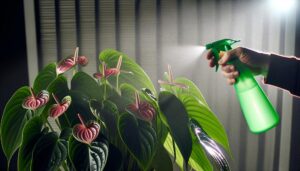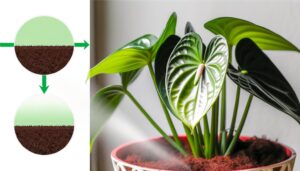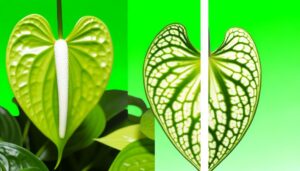Anthurium Pallidiflorum Care Complete How-To Guide
Anthurium Pallidiflorum thrives under bright, indirect light, ideally near east or north-facing windows. Water when the top inch of the substrate is dry, using distilled or rainwater to avoid salt buildup.
A well-draining soil mix of 40% orchid bark, 30% perlite, and 30% peat moss is crucial. Maintain temperatures between 65-80°F and relative humidity levels between 70-90%.
Fertilize bi-weekly during the growing season with a balanced 20-20-20 NPK fertilizer, reducing frequency in winter. Monitoring these conditions closely promotes plant health and vitality, with additional insights available for those seeking more detailed guidance.
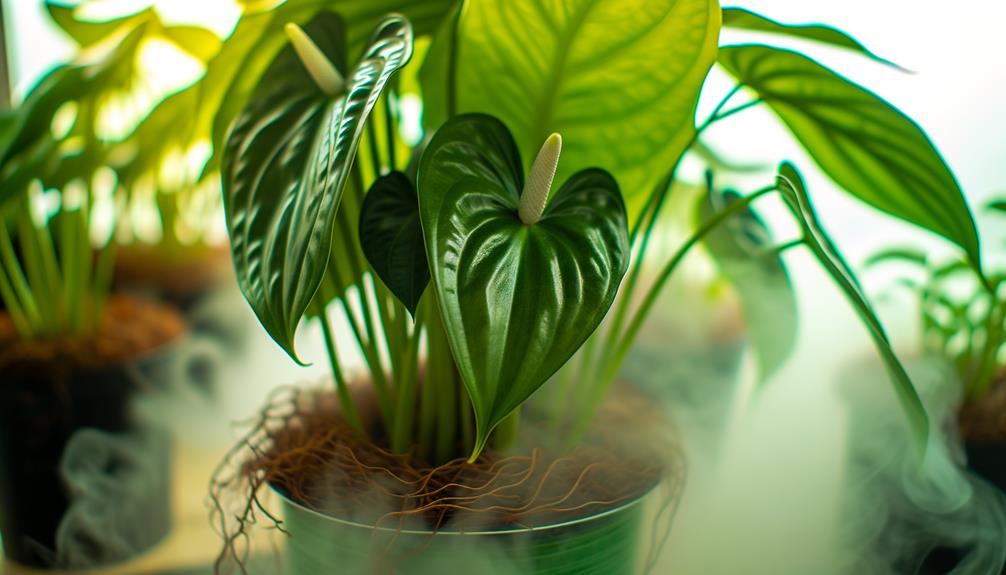
Key Takeaways
- Provide bright, indirect light from east or north-facing windows to support optimal growth.
- Water when the top inch of substrate is dry, using distilled or rainwater to avoid salt buildup.
- Use a well-draining soil mix of 40% orchid bark, 30% perlite, and 30% peat moss.
- Maintain temperature between 65-80°F and humidity levels between 70-90% for ideal conditions.
- Fertilize bi-weekly with a balanced 20-20-20 N-P-K ratio during the growing season, reducing to monthly in winter.
Ideal Lighting Conditions

Providing ideal lighting conditions for Anthurium Pallidiflorum involves giving bright, indirect light to replicate its natural understory habitat.
This tropical plant flourishes under filtered sunlight, typically found beneath the dense canopy of rainforests.
Placing it near an east-facing window, where it receives soft morning light, or a north-facing window, promotes optimal growth.
Avoiding direct sunlight, which can damage the delicate foliage, causing discoloration and leaf burn.
Artificial grow lights can supplement natural light, especially in areas with limited sunlight. Maintaining a consistent photoperiod of 10-12 hours to mimic its natural environment.
Additionally, rotating the plant periodically ensures even light exposure, promoting uniform growth. Monitoring light intensity with a light meter can offer precise adjustments to meet its needs.
Watering Practices
Proper hydration management is crucial for maintaining the health and vigor of Anthurium Pallidiflorum, necessitating a balance between consistent moisture and sufficient aeration to prevent root rot.
Watering should be done when the top inch of the substrate feels dry to the touch. Utilize distilled or rainwater to avoid the potential accumulation of harmful salts and chemicals found in tap water.
Ensure thorough watering until excess liquid drains from the bottom, guaranteeing the root zone receives adequate moisture.
Employing a humidity tray or misting can supplement ambient moisture levels, especially in arid conditions.
Regularly monitor environmental humidity, aiming for levels between 60-80%, as insufficient humidity can lead to desiccation, adversely affecting plant health.
Soil Mix
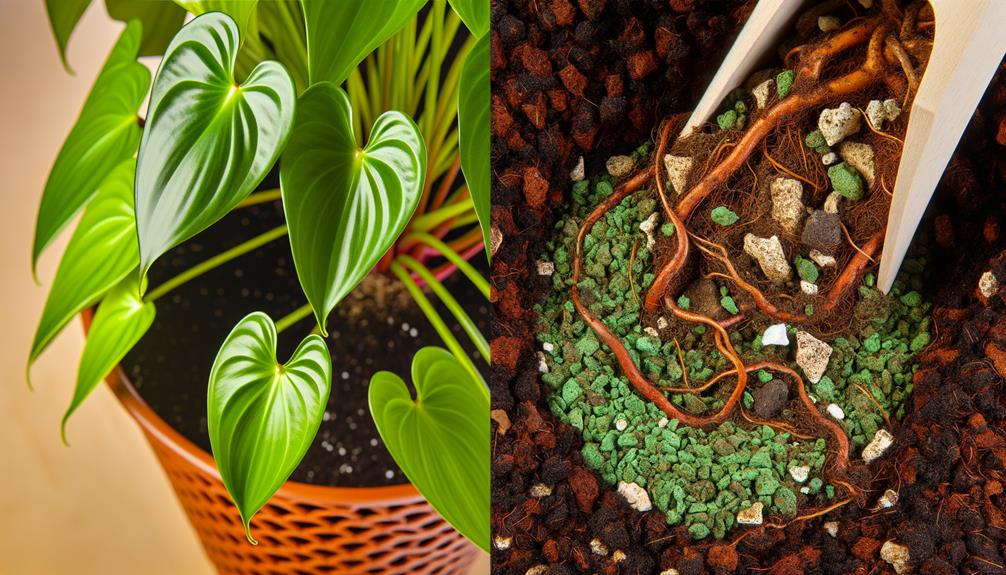
Selecting an ideal soil mix for Anthurium Pallidiflorum requires a well-draining, aerated substrate made up of components such as orchid bark, perlite, and peat moss to replicate its natural epiphytic environment.
Orchid bark provides structural integrity and aeration, promoting root breathability. Perlite improves drainage, preventing water stagnation that could cause root rot. Peat moss retains moisture while maintaining acidity, essential for nutrient uptake.
A recommended ratio is 40% orchid bark, 30% perlite, and 30% peat moss. Regularly inspect the soil’s condition to ensure it remains loose and well-draining. Renew or refresh the mix annually to maintain the best growth conditions.
This detailed approach guarantees that Anthurium Pallidiflorum flourishes, mirroring the delicate balance of its native habitat.
Temperature and Humidity
Maintaining perfect temperature and humidity levels is crucial for Anthurium Pallidiflorum to thrive, requiring a consistent temperature range of 65-80°F and relative humidity levels of 70-90%.
Deviations from these parameters can lead to stress and diminished growth. Indoors, consider using a humidifier or humidity tray to sustain the ideal conditions. It is also advisable to avoid sudden temperature fluctuations and drafts, which can negatively impact the plant’s health.
The following table summarizes the specific requirements for temperature and humidity:
| Parameter | Perfect Range |
|---|---|
| Temperature | 65-80°F (18-27°C) |
| Relative Humidity | 70-90% |
Fertilization Tips

In addition to maintaining ideal temperature and humidity levels, providing the right fertilization regimen is key to promoting vigorous growth and vibrant foliage for Anthurium Pallidiflorum.
Utilize a balanced, water-soluble fertilizer with an N-P-K ratio of 20-20-20, diluted to half strength. Administer this solution bi-weekly during the growing season, from spring to early autumn.
During the dormant winter months, reduce fertilization to once a month, using a quarter-strength solution to avoid over-fertilization. Make sure the soil is moist before application to prevent root burn.
Incorporate micronutrients such as magnesium and calcium to support overall plant health. Monitoring the plant’s response to fertilization will help in adjusting the regimen for best results.
Common Issues
When caring for Anthurium Pallidiflorum, practitioners must address common issues such as yellowing leaves and pest infestations.
Yellowing leaves often indicate improper watering, nutrient deficiencies, or inadequate light conditions.
Additionally, signs of pest infestations, including aphids and spider mites, require immediate intervention through appropriate insecticidal treatments and environmental adjustments.
Yellowing Leaves Causes
Yellowing leaves in Anthurium pallidiflorum can often be attributed to improper watering practices, nutrient deficiencies, or pest infestations. Overwatering can lead to root rot, which impedes nutrient uptake, causing chlorosis.
Conversely, underwatering deprives the plant of essential hydration, resulting in similar yellowing. Ensuring consistent moisture without waterlogging is vital.
Nutrient deficiencies, particularly nitrogen, magnesium, and iron, manifest as yellowing leaves. Regularly applying a balanced, slow-release fertilizer can mitigate this. Conduct soil tests to identify specific nutrient gaps.
Pest infestations, such as spider mites or aphids, can also cause yellowing by damaging leaf tissues and disrupting photosynthesis. Routine inspection and appropriate pest management practices are necessary.
Pest Infestation Signs
Identifying pest infestation signs in Anthurium pallidiflorum is crucial for early intervention and effective management of common issues such as spider mites, aphids, and scale insects.
Key indicators include stippling and discoloration on leaves, which are symptoms of spider mite activity.
Aphids often cause leaf curling and a sticky residue known as honeydew, which can lead to sooty mold.
Scale insects appear as small, brown, and immobile bumps on stems and undersides of leaves, and their feeding may result in chlorotic spots and overall plant decline.
Regularly inspect the plant with a magnifying glass, especially the undersides of leaves, and maintain ideal humidity levels to deter these pests.
Immediate action includes mechanical removal and applying horticultural oils or insecticidal soaps.
Anthurium Pallidiflorum Propagation
Anthurium pallidiflorum can be propagated through stem cuttings or division. Here’s a quick guide:
- Select a Cutting: Choose a healthy stem with aerial roots.
- Prepare: Cut the stem just below a set of leaves and aerial roots using sterilized scissors.
- Rooting: Plant the cutting in a well-draining potting mix, ensuring aerial roots are below the soil surface.
- Environment: Keep the soil moist and place the plant in indirect, bright light.
- Care: Maintain high humidity and temperatures around 70-80°F (21-27°C) to encourage rooting.
This method should result in new growth within a few weeks to a couple of months.
Conclusion
To sum up, mastering the care of Anthurium pallidiflorum demands careful attention to its specific requirements. This includes ideal lighting, precise watering, well-draining soil mix, and controlled temperature and humidity.
Regular fertilization and vigilance against common issues will promote strong growth. Concerns about the complexity of these requirements are lessened by the plant’s rewarding display of lush foliage, making the effort worthwhile for enthusiasts and experts alike.
Proper adherence to these guidelines will result in a flourishing Anthurium pallidiflorum.

